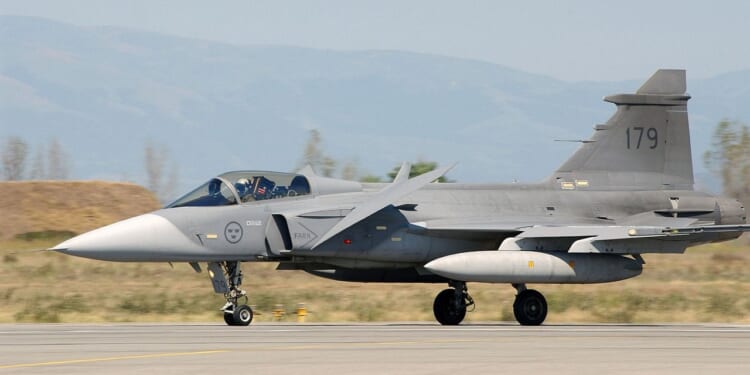Sweden’s Defense Ministry ordered 60 Gripen E fighters to supplement its existing C and D variants in 2013, but received the first batch in the order only this week.
NATO member Sweden took delivery of a modernized version of its highly touted, domestically built multirole jet fighter on Monday. At a ceremony attended by Minister of Defense Pål Jonson at the Skaraborg Air Wing (F 7) in Såtenäs, the Swedish Air Force (SwAF) received its first Saab JAS 39 Gripen E.
“Gripen E is an example of Sweden’s technological edge, and a modern combat aircraft that, in almost every respect, is entirely new,” Jonson wrote in a post on X (formerly Twitter). “The aircraft includes advanced electronic-warfare systems and can receive new software updates within hours. This enables rapid innovation and flexibility. Gripen E is also being tested with AI capabilities that have attracted international attention.”
Sweden Has Waited for New Gripens for 12 Years
Stockholm first ordered a batch of 60 new JAS 39 Gripen E aircraft in 2013, but the new aircraft’s production faced multiple delays, including software development and integration challenges. There had also been budgetary pressure, but the Swedish military put an emphasis on the aircraft following Russia’s unprovoked invasion of Ukraine in February 2022—which also resulted in the historically neutral Nordic country joining NATO.
“This marks an important milestone in the development of the Swedish defense. The result of long-term cooperation and close collaboration between the Armed Forces, FMV and Swedish industry. Gripen E strengthens our national defense capability to meet future threats together with allies. Continue to make us proud,” explained Swedish Air Force Commander-in-Chief Michael Claesson following the aircraft’s delivery.
The Gripen E Fighter’s Specifications
- Year Introduced: 2025
- Number Built: Unknown (60 ordered)
- Length: 15.2 m (49.8 ft)
- Wingspan: 8.6 m (28.2 ft)
- Weight (MTOW): 16,500 kg (36,376 lb)
- Engines: One General Electric F414G afterburning turbofan engine
- Top Speed: ~1,100 knots (2,037 km/h, 1,266 mph)
- Combat Range: ~1,300 km (810 mi)
- Service Ceiling: 15,850 m (52,000 ft)
- Loadout: One Mauser BK-27 27mm single-barrel revolver cannon; 10 hardpoints; ~7,200 kg (15,873 lb) payload capacity
- Aircrew: 1
How the Gripen E Improves on Its Predecessors
The latest variation of the Saab JAS 39, the Gripen E, offers a more extended range and can carry a larger payload than the Gripen C/D models now in service. It is further outfitted with a new system of sensors, radar, and communication systems, and more advanced software, including the Raven ES-05 AESA radar, the Skyward-G infrared search and track system, and the Areix electronic warfare (EW) suite.
The Gripen E is equipped with the more powerful GE F414G engine, includes increased fuel capacity, and features 10 external hardpoints that allow it to carry a large weapons load or sensors. Among the weapons that the Gripen E can carry are the Meteor beyond-visual-range (BVR) missile and the IRIS-T short-range infrared homing air-to-air missile for close-range threats.
According to the Swedish military, the changes will improve the capabilities of the JAS 39, but won’t create a difficult learning curve for current aviators.
“Pilots who have flown the JAS 39 Gripen C/D will recognize themselves in the E. The difference lies in how the pilot makes decisions in the new E. There is much more information to deal with, more sensors and other weapons,” the Swedish defense ministry explained.
The JAS 39 Gripen E will still be able to operate from austere environments, including auxiliary runways and stretches of road or highway.
Sweden Is Already Looking Beyond the Gripen
Even as the SwAF received its first Gripen E, it is already looking towards a future sixth-generation manned fighter that is being developed by Saab, GKN Aerospace, and the Swedish Defence Materiel Administration (Försvarets Materielverk or FMV).
Development of the KFS began in March 2024. As part of the Phase 1 efforts, Saab and GKN have spent the last 19 months conducting studies on the required technologies, developing the aircraft’s future capabilities, and preparing for future flight demonstrators. The subsequent Phase 2 will focus on the development of the technology and demonstrators, potentially extending through 2030, with further development in the early 2030s.
Stockholm had previously been part of the Team Tempest program with the UK and Italy. However, Stockholm opted not to remain with the effort as it evolved into the UK-led “Global Combat Air Programme” (GCAP), which merged with Japan’s F-X program in 2022.
There were reports earlier this month that Canada had delayed its final decision on whether to acquire the F-35 Lightning II and was weighing its options. That has included another look at the JAS 39 Gripen E, which Canada previously rejected in favor of the fifth-generation Lightning II.
However, Russia’s introduction of the fifth-generation Sukhoi Su-57 (NATO reporting name “Felon”) ,China’s efforts to adopt the Chengdu J-20 Mighty Dragon and Shenyang J-35, and Beijing’s efforts to develop the sixth-generation J-36,may be enough to push Ottawa back to the F-35.
About the Author: Peter Suciu
Peter Suciu has contributed over 3,200 published pieces to more than four dozen magazines and websites over a 30-year career in journalism. He regularly writes about military hardware, firearms history, cybersecurity, politics, and international affairs. Peter is also a contributing writer for Forbes and Clearance Jobs. He is based in Michigan. You can follow him on Twitter: @PeterSuciu. You can email the author: [email protected].
Image: Wikimedia Commons.


















